Sustainable Enterprise Report: Sustainability in Business Operations
VerifiedAdded on 2022/11/14
|11
|2963
|148
Report
AI Summary
This report delves into the sustainable management system of NIELSEN’S NATIVE NURSERY, a family-operated business in South East Queensland. It begins by highlighting the importance of sustainability in contemporary business and the need for effective monitoring systems. The report then analyzes the characteristics of good monitoring systems, emphasizing validity, reliability, clarity, and measurability. An enterprise profile of NIELSEN’S NATIVE NURSERY is provided, followed by a discussion of its sustainability dimensions, specifically environmental, socio-cultural, and economic aspects. The social dimension is identified as the most suitable for the nursery. The report concludes with an assessment of indicators for monitoring sustainability, including sustainable energy usage, global warming potential, and waste treatment, along with the challenges associated with each.

Running head: SUSTAINABLE ENTERPRISE
Sustainable enterprise
Name of the student
Name of the university
Author note
Sustainable enterprise
Name of the student
Name of the university
Author note
Paraphrase This Document
Need a fresh take? Get an instant paraphrase of this document with our AI Paraphraser

1SUSTAINABLE ENTERPRISE
Table of Contents
Introduction......................................................................................................................................2
Characteristics of good monitoring systems....................................................................................2
Enterprise profile.............................................................................................................................3
Sustainability dimensions................................................................................................................3
Identification of the specific sustainability area..............................................................................5
List and assessment of indicators for monitoring............................................................................5
Conclusion.......................................................................................................................................7
Reference.........................................................................................................................................8
Table of Contents
Introduction......................................................................................................................................2
Characteristics of good monitoring systems....................................................................................2
Enterprise profile.............................................................................................................................3
Sustainability dimensions................................................................................................................3
Identification of the specific sustainability area..............................................................................5
List and assessment of indicators for monitoring............................................................................5
Conclusion.......................................................................................................................................7
Reference.........................................................................................................................................8

2SUSTAINABLE ENTERPRISE
Introduction
In the current business scenario, it is important for the contemporary business enterprises
to ensure the sustainability in their operation. This is due to the reason that sustainability is being
expected in terms of environmental, social and economical dimensions from the business
entities. Currently, almost all the large and small scale organizations are following and practicing
the sustainable practices. In addition, the sustainability reporting is also being published by
major business firms (Martinez & del Bosque, 2014). However, in this case, it should be noted
that indicators are important for the enterprises to monitor their sustainable activities and the
extent to which the initiated activities are meeting the sustainable objectives. Hence, good
monitoring systems are important for sustainable management system in the enterprise.
This report will discuss about the sustainable management system of NIELSEN’S
NATIVE NURSERY along with the critical analysis of the characteristics of good monitoring
systems. In addition, this report will also discuss about the three major and core dimensions of
sustainability from the perspectives of NIELSEN’S NATIVE NURSERY. Among the three
dimensions, the most effective and suitable one for NIELSEN’S NATIVE NURSERY will be
selected based on this dimension, different indicators will be discussed. Each of these indicators
will be critically analyzed.
Characteristics of good monitoring systems
Implementation of the different indicators is not enough for measuring and monitoring
the sustainable performance. Thus, it is important for the enterprises to initiate good indicators
and it is also important to have the proper understanding about the characteristics and features of
good indicators. According to Issa et al. (2015), one of the major characteristics of good
monitoring system is validity, which refers to the accuracy of the monitoring process in line to
the sustainable objectives. As per the authors, if the monitoring system is not valid and accurate
enough, then it will be difficult for the enterprise to measure the success of the sustainable
activities. For instance, if the objective is to reduce the environmental impact, then the
measurements should also be valid in line to the environmental factors or the results or outcome
will be different. On the other hand, it is stated by Whitehead (2017) that reliability is another
element required for the good monitoring system. According to the author, the monitoring
Introduction
In the current business scenario, it is important for the contemporary business enterprises
to ensure the sustainability in their operation. This is due to the reason that sustainability is being
expected in terms of environmental, social and economical dimensions from the business
entities. Currently, almost all the large and small scale organizations are following and practicing
the sustainable practices. In addition, the sustainability reporting is also being published by
major business firms (Martinez & del Bosque, 2014). However, in this case, it should be noted
that indicators are important for the enterprises to monitor their sustainable activities and the
extent to which the initiated activities are meeting the sustainable objectives. Hence, good
monitoring systems are important for sustainable management system in the enterprise.
This report will discuss about the sustainable management system of NIELSEN’S
NATIVE NURSERY along with the critical analysis of the characteristics of good monitoring
systems. In addition, this report will also discuss about the three major and core dimensions of
sustainability from the perspectives of NIELSEN’S NATIVE NURSERY. Among the three
dimensions, the most effective and suitable one for NIELSEN’S NATIVE NURSERY will be
selected based on this dimension, different indicators will be discussed. Each of these indicators
will be critically analyzed.
Characteristics of good monitoring systems
Implementation of the different indicators is not enough for measuring and monitoring
the sustainable performance. Thus, it is important for the enterprises to initiate good indicators
and it is also important to have the proper understanding about the characteristics and features of
good indicators. According to Issa et al. (2015), one of the major characteristics of good
monitoring system is validity, which refers to the accuracy of the monitoring process in line to
the sustainable objectives. As per the authors, if the monitoring system is not valid and accurate
enough, then it will be difficult for the enterprise to measure the success of the sustainable
activities. For instance, if the objective is to reduce the environmental impact, then the
measurements should also be valid in line to the environmental factors or the results or outcome
will be different. On the other hand, it is stated by Whitehead (2017) that reliability is another
element required for the good monitoring system. According to the author, the monitoring
⊘ This is a preview!⊘
Do you want full access?
Subscribe today to unlock all pages.

Trusted by 1+ million students worldwide
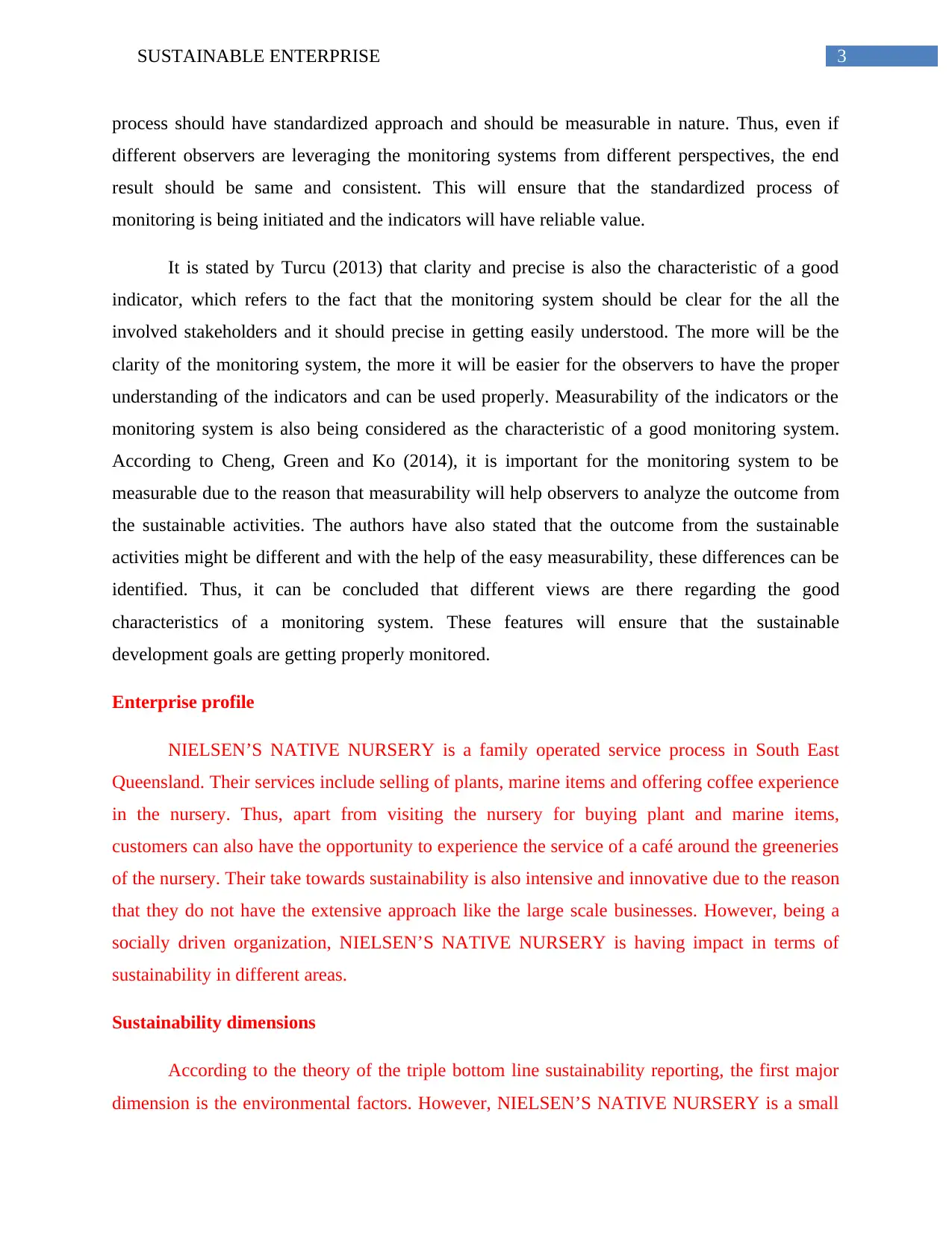
3SUSTAINABLE ENTERPRISE
process should have standardized approach and should be measurable in nature. Thus, even if
different observers are leveraging the monitoring systems from different perspectives, the end
result should be same and consistent. This will ensure that the standardized process of
monitoring is being initiated and the indicators will have reliable value.
It is stated by Turcu (2013) that clarity and precise is also the characteristic of a good
indicator, which refers to the fact that the monitoring system should be clear for the all the
involved stakeholders and it should precise in getting easily understood. The more will be the
clarity of the monitoring system, the more it will be easier for the observers to have the proper
understanding of the indicators and can be used properly. Measurability of the indicators or the
monitoring system is also being considered as the characteristic of a good monitoring system.
According to Cheng, Green and Ko (2014), it is important for the monitoring system to be
measurable due to the reason that measurability will help observers to analyze the outcome from
the sustainable activities. The authors have also stated that the outcome from the sustainable
activities might be different and with the help of the easy measurability, these differences can be
identified. Thus, it can be concluded that different views are there regarding the good
characteristics of a monitoring system. These features will ensure that the sustainable
development goals are getting properly monitored.
Enterprise profile
NIELSEN’S NATIVE NURSERY is a family operated service process in South East
Queensland. Their services include selling of plants, marine items and offering coffee experience
in the nursery. Thus, apart from visiting the nursery for buying plant and marine items,
customers can also have the opportunity to experience the service of a café around the greeneries
of the nursery. Their take towards sustainability is also intensive and innovative due to the reason
that they do not have the extensive approach like the large scale businesses. However, being a
socially driven organization, NIELSEN’S NATIVE NURSERY is having impact in terms of
sustainability in different areas.
Sustainability dimensions
According to the theory of the triple bottom line sustainability reporting, the first major
dimension is the environmental factors. However, NIELSEN’S NATIVE NURSERY is a small
process should have standardized approach and should be measurable in nature. Thus, even if
different observers are leveraging the monitoring systems from different perspectives, the end
result should be same and consistent. This will ensure that the standardized process of
monitoring is being initiated and the indicators will have reliable value.
It is stated by Turcu (2013) that clarity and precise is also the characteristic of a good
indicator, which refers to the fact that the monitoring system should be clear for the all the
involved stakeholders and it should precise in getting easily understood. The more will be the
clarity of the monitoring system, the more it will be easier for the observers to have the proper
understanding of the indicators and can be used properly. Measurability of the indicators or the
monitoring system is also being considered as the characteristic of a good monitoring system.
According to Cheng, Green and Ko (2014), it is important for the monitoring system to be
measurable due to the reason that measurability will help observers to analyze the outcome from
the sustainable activities. The authors have also stated that the outcome from the sustainable
activities might be different and with the help of the easy measurability, these differences can be
identified. Thus, it can be concluded that different views are there regarding the good
characteristics of a monitoring system. These features will ensure that the sustainable
development goals are getting properly monitored.
Enterprise profile
NIELSEN’S NATIVE NURSERY is a family operated service process in South East
Queensland. Their services include selling of plants, marine items and offering coffee experience
in the nursery. Thus, apart from visiting the nursery for buying plant and marine items,
customers can also have the opportunity to experience the service of a café around the greeneries
of the nursery. Their take towards sustainability is also intensive and innovative due to the reason
that they do not have the extensive approach like the large scale businesses. However, being a
socially driven organization, NIELSEN’S NATIVE NURSERY is having impact in terms of
sustainability in different areas.
Sustainability dimensions
According to the theory of the triple bottom line sustainability reporting, the first major
dimension is the environmental factors. However, NIELSEN’S NATIVE NURSERY is a small
Paraphrase This Document
Need a fresh take? Get an instant paraphrase of this document with our AI Paraphraser

4SUSTAINABLE ENTERPRISE
scale family run entity and thus they do not have the requirement for reporting the triple bottom
line standards not they have the capability. In terms of the environmental dimension, it is
identified that the greeneries being maintained in the nursery is offsetting the carbon emission
from the business activities of them. This is also identified that NIELSEN’S NATIVE
NURSERY is leveraging only on the renewable sources of energy for their daily needs and
maximum utilization of the solar energy is identified (Winter & Knemeyer, 2013). This is also
ensuring that the environmental impact of the activities of NIELSEN’S NATIVE NURSERY is
limited. It is also identified that the manure and fertilizers and pesticides being used and sold by
them are organic and no artificial chemicals are being used. This is ensuring that the impact on
the environment from the plantation activities are also restricted (Becker et al., 2015).
In terms of the socio-cultural dimensions also, there are number of initiatives being taken
by NIELSEN’S NATIVE NURSERY. It is identified that focus of the socio cultural dimension
of them is more towards the value proposition of the customers. This is due to the fact that
customers are offered the sustainable service including café among the greens and availability of
different marine and plants items in one place. The service process of NIELSEN’S NATIVE
NURSERY is designed on the basis of the expectations of the customers (Seuring & Gold,
2013). For instance, customers are having few options in terms of café experience in open and
tranquil settings, which is being offered by NIELSEN’S NATIVE NURSERY. Thus, the service
approach of them is sustainable compared to their conventional competitors (Hahn et al., 2015).
The socio cultural dimension of NIELSEN’S NATIVE NURSERY also includes the
proper value proposition to the customers. This is due to the fact that as per the official website
of them, the plants and the marine products sustainable in terms of lasting abilities. Hence, the
customers purchasing the plants from NIELSEN’S NATIVE NURSERY will have it for long
term (Stefanska & Nestorowicz, 2015). The plants and marine products of NIELSEN’S NATIVE
NURSERY are treated in the way that they will be able to withstand the impacts of pests and
other adverse factors. This is ensuring the value proposition to be proper for the customers.
In terms of the economical dimension of the sustainability, it is identified that
NIELSEN’S NATIVE NURSERY is witnessing of increasing trend of profitability in their
business operations. This is mainly due to their unique service approach. The addition of the
sustainable elements in the service process is adding the value to the customers. For instance,
scale family run entity and thus they do not have the requirement for reporting the triple bottom
line standards not they have the capability. In terms of the environmental dimension, it is
identified that the greeneries being maintained in the nursery is offsetting the carbon emission
from the business activities of them. This is also identified that NIELSEN’S NATIVE
NURSERY is leveraging only on the renewable sources of energy for their daily needs and
maximum utilization of the solar energy is identified (Winter & Knemeyer, 2013). This is also
ensuring that the environmental impact of the activities of NIELSEN’S NATIVE NURSERY is
limited. It is also identified that the manure and fertilizers and pesticides being used and sold by
them are organic and no artificial chemicals are being used. This is ensuring that the impact on
the environment from the plantation activities are also restricted (Becker et al., 2015).
In terms of the socio-cultural dimensions also, there are number of initiatives being taken
by NIELSEN’S NATIVE NURSERY. It is identified that focus of the socio cultural dimension
of them is more towards the value proposition of the customers. This is due to the fact that
customers are offered the sustainable service including café among the greens and availability of
different marine and plants items in one place. The service process of NIELSEN’S NATIVE
NURSERY is designed on the basis of the expectations of the customers (Seuring & Gold,
2013). For instance, customers are having few options in terms of café experience in open and
tranquil settings, which is being offered by NIELSEN’S NATIVE NURSERY. Thus, the service
approach of them is sustainable compared to their conventional competitors (Hahn et al., 2015).
The socio cultural dimension of NIELSEN’S NATIVE NURSERY also includes the
proper value proposition to the customers. This is due to the fact that as per the official website
of them, the plants and the marine products sustainable in terms of lasting abilities. Hence, the
customers purchasing the plants from NIELSEN’S NATIVE NURSERY will have it for long
term (Stefanska & Nestorowicz, 2015). The plants and marine products of NIELSEN’S NATIVE
NURSERY are treated in the way that they will be able to withstand the impacts of pests and
other adverse factors. This is ensuring the value proposition to be proper for the customers.
In terms of the economical dimension of the sustainability, it is identified that
NIELSEN’S NATIVE NURSERY is witnessing of increasing trend of profitability in their
business operations. This is mainly due to their unique service approach. The addition of the
sustainable elements in the service process is adding the value to the customers. For instance,
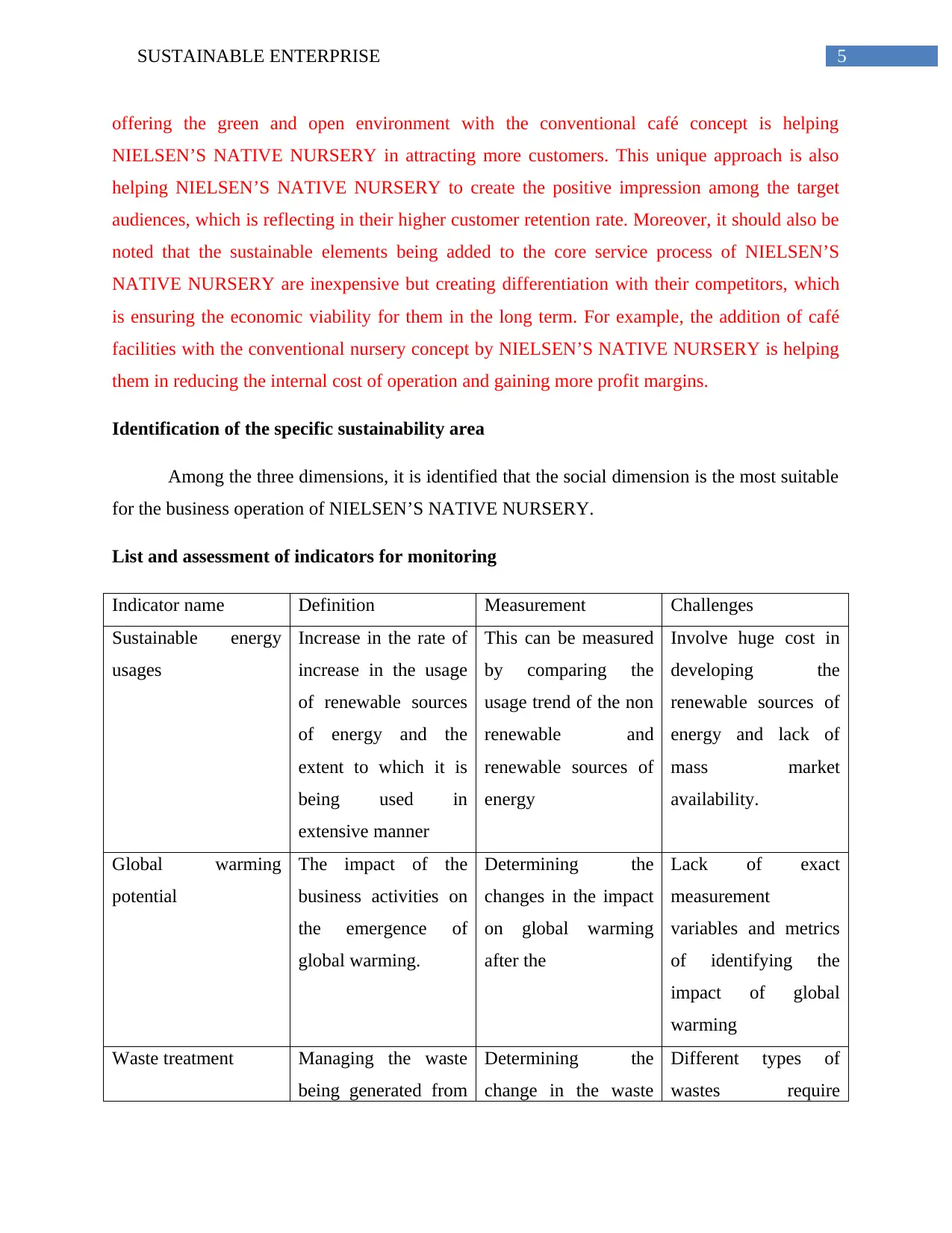
5SUSTAINABLE ENTERPRISE
offering the green and open environment with the conventional café concept is helping
NIELSEN’S NATIVE NURSERY in attracting more customers. This unique approach is also
helping NIELSEN’S NATIVE NURSERY to create the positive impression among the target
audiences, which is reflecting in their higher customer retention rate. Moreover, it should also be
noted that the sustainable elements being added to the core service process of NIELSEN’S
NATIVE NURSERY are inexpensive but creating differentiation with their competitors, which
is ensuring the economic viability for them in the long term. For example, the addition of café
facilities with the conventional nursery concept by NIELSEN’S NATIVE NURSERY is helping
them in reducing the internal cost of operation and gaining more profit margins.
Identification of the specific sustainability area
Among the three dimensions, it is identified that the social dimension is the most suitable
for the business operation of NIELSEN’S NATIVE NURSERY.
List and assessment of indicators for monitoring
Indicator name Definition Measurement Challenges
Sustainable energy
usages
Increase in the rate of
increase in the usage
of renewable sources
of energy and the
extent to which it is
being used in
extensive manner
This can be measured
by comparing the
usage trend of the non
renewable and
renewable sources of
energy
Involve huge cost in
developing the
renewable sources of
energy and lack of
mass market
availability.
Global warming
potential
The impact of the
business activities on
the emergence of
global warming.
Determining the
changes in the impact
on global warming
after the
Lack of exact
measurement
variables and metrics
of identifying the
impact of global
warming
Waste treatment Managing the waste
being generated from
Determining the
change in the waste
Different types of
wastes require
offering the green and open environment with the conventional café concept is helping
NIELSEN’S NATIVE NURSERY in attracting more customers. This unique approach is also
helping NIELSEN’S NATIVE NURSERY to create the positive impression among the target
audiences, which is reflecting in their higher customer retention rate. Moreover, it should also be
noted that the sustainable elements being added to the core service process of NIELSEN’S
NATIVE NURSERY are inexpensive but creating differentiation with their competitors, which
is ensuring the economic viability for them in the long term. For example, the addition of café
facilities with the conventional nursery concept by NIELSEN’S NATIVE NURSERY is helping
them in reducing the internal cost of operation and gaining more profit margins.
Identification of the specific sustainability area
Among the three dimensions, it is identified that the social dimension is the most suitable
for the business operation of NIELSEN’S NATIVE NURSERY.
List and assessment of indicators for monitoring
Indicator name Definition Measurement Challenges
Sustainable energy
usages
Increase in the rate of
increase in the usage
of renewable sources
of energy and the
extent to which it is
being used in
extensive manner
This can be measured
by comparing the
usage trend of the non
renewable and
renewable sources of
energy
Involve huge cost in
developing the
renewable sources of
energy and lack of
mass market
availability.
Global warming
potential
The impact of the
business activities on
the emergence of
global warming.
Determining the
changes in the impact
on global warming
after the
Lack of exact
measurement
variables and metrics
of identifying the
impact of global
warming
Waste treatment Managing the waste
being generated from
Determining the
change in the waste
Different types of
wastes require
⊘ This is a preview!⊘
Do you want full access?
Subscribe today to unlock all pages.

Trusted by 1+ million students worldwide
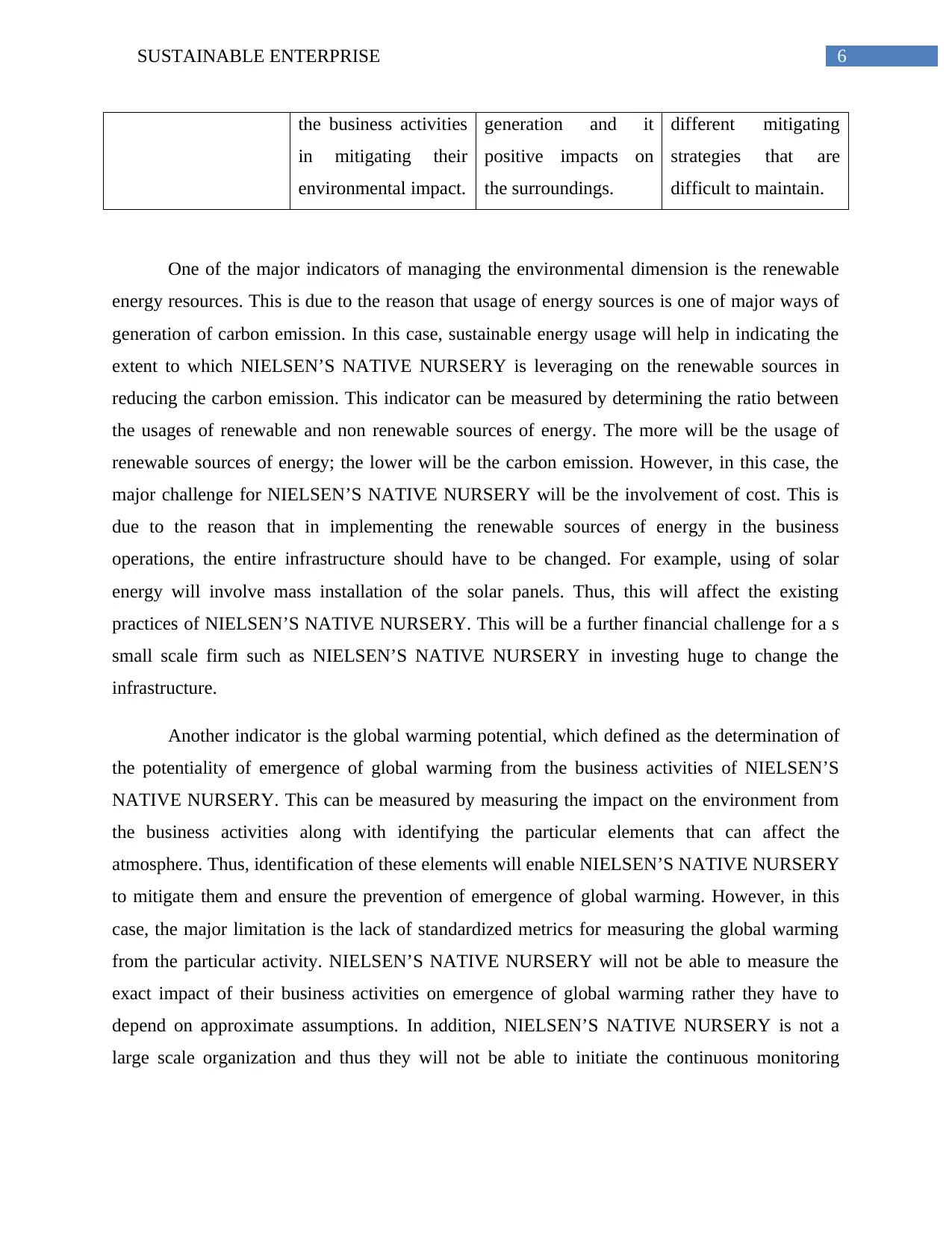
6SUSTAINABLE ENTERPRISE
the business activities
in mitigating their
environmental impact.
generation and it
positive impacts on
the surroundings.
different mitigating
strategies that are
difficult to maintain.
One of the major indicators of managing the environmental dimension is the renewable
energy resources. This is due to the reason that usage of energy sources is one of major ways of
generation of carbon emission. In this case, sustainable energy usage will help in indicating the
extent to which NIELSEN’S NATIVE NURSERY is leveraging on the renewable sources in
reducing the carbon emission. This indicator can be measured by determining the ratio between
the usages of renewable and non renewable sources of energy. The more will be the usage of
renewable sources of energy; the lower will be the carbon emission. However, in this case, the
major challenge for NIELSEN’S NATIVE NURSERY will be the involvement of cost. This is
due to the reason that in implementing the renewable sources of energy in the business
operations, the entire infrastructure should have to be changed. For example, using of solar
energy will involve mass installation of the solar panels. Thus, this will affect the existing
practices of NIELSEN’S NATIVE NURSERY. This will be a further financial challenge for a s
small scale firm such as NIELSEN’S NATIVE NURSERY in investing huge to change the
infrastructure.
Another indicator is the global warming potential, which defined as the determination of
the potentiality of emergence of global warming from the business activities of NIELSEN’S
NATIVE NURSERY. This can be measured by measuring the impact on the environment from
the business activities along with identifying the particular elements that can affect the
atmosphere. Thus, identification of these elements will enable NIELSEN’S NATIVE NURSERY
to mitigate them and ensure the prevention of emergence of global warming. However, in this
case, the major limitation is the lack of standardized metrics for measuring the global warming
from the particular activity. NIELSEN’S NATIVE NURSERY will not be able to measure the
exact impact of their business activities on emergence of global warming rather they have to
depend on approximate assumptions. In addition, NIELSEN’S NATIVE NURSERY is not a
large scale organization and thus they will not be able to initiate the continuous monitoring
the business activities
in mitigating their
environmental impact.
generation and it
positive impacts on
the surroundings.
different mitigating
strategies that are
difficult to maintain.
One of the major indicators of managing the environmental dimension is the renewable
energy resources. This is due to the reason that usage of energy sources is one of major ways of
generation of carbon emission. In this case, sustainable energy usage will help in indicating the
extent to which NIELSEN’S NATIVE NURSERY is leveraging on the renewable sources in
reducing the carbon emission. This indicator can be measured by determining the ratio between
the usages of renewable and non renewable sources of energy. The more will be the usage of
renewable sources of energy; the lower will be the carbon emission. However, in this case, the
major challenge for NIELSEN’S NATIVE NURSERY will be the involvement of cost. This is
due to the reason that in implementing the renewable sources of energy in the business
operations, the entire infrastructure should have to be changed. For example, using of solar
energy will involve mass installation of the solar panels. Thus, this will affect the existing
practices of NIELSEN’S NATIVE NURSERY. This will be a further financial challenge for a s
small scale firm such as NIELSEN’S NATIVE NURSERY in investing huge to change the
infrastructure.
Another indicator is the global warming potential, which defined as the determination of
the potentiality of emergence of global warming from the business activities of NIELSEN’S
NATIVE NURSERY. This can be measured by measuring the impact on the environment from
the business activities along with identifying the particular elements that can affect the
atmosphere. Thus, identification of these elements will enable NIELSEN’S NATIVE NURSERY
to mitigate them and ensure the prevention of emergence of global warming. However, in this
case, the major limitation is the lack of standardized metrics for measuring the global warming
from the particular activity. NIELSEN’S NATIVE NURSERY will not be able to measure the
exact impact of their business activities on emergence of global warming rather they have to
depend on approximate assumptions. In addition, NIELSEN’S NATIVE NURSERY is not a
large scale organization and thus they will not be able to initiate the continuous monitoring
Paraphrase This Document
Need a fresh take? Get an instant paraphrase of this document with our AI Paraphraser
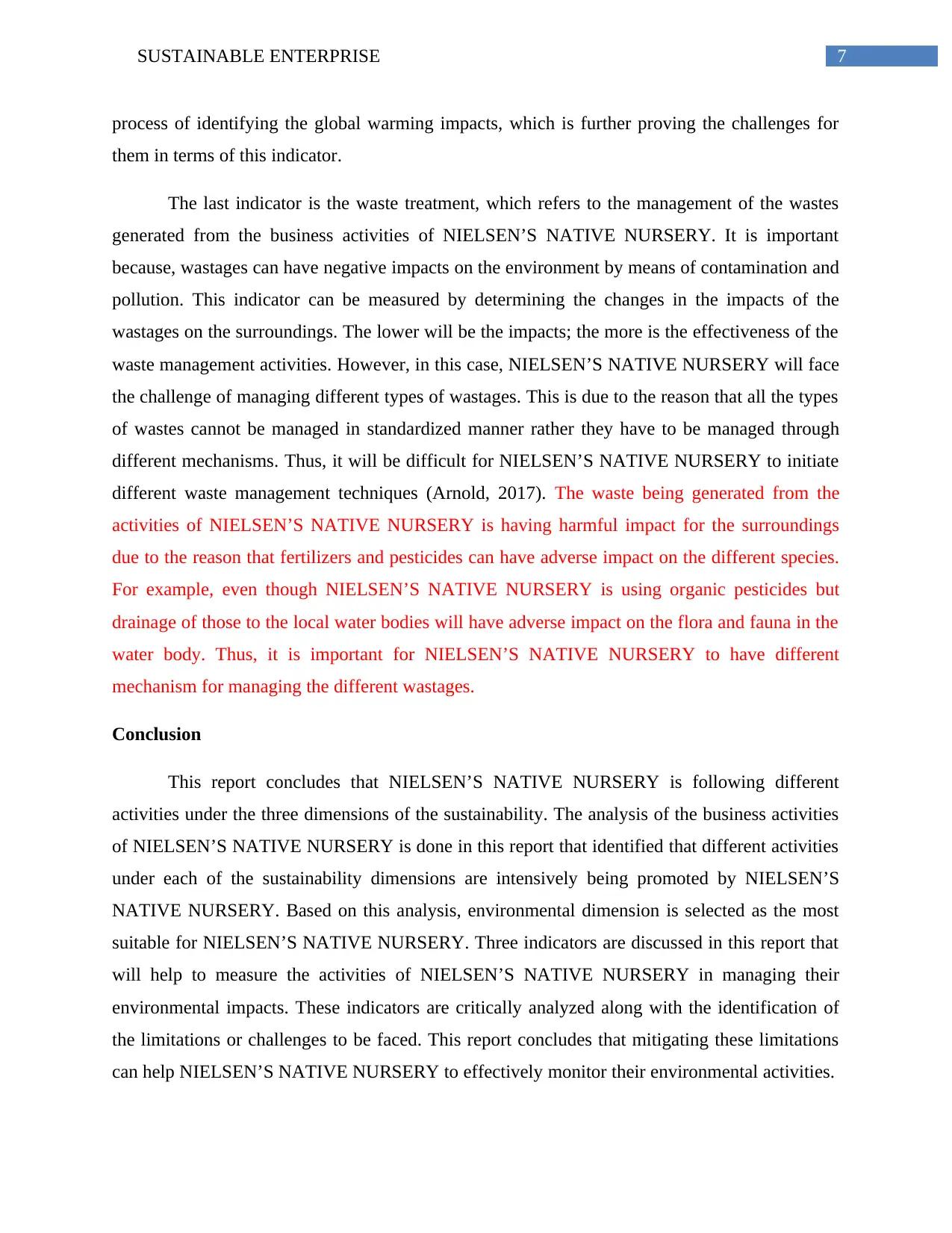
7SUSTAINABLE ENTERPRISE
process of identifying the global warming impacts, which is further proving the challenges for
them in terms of this indicator.
The last indicator is the waste treatment, which refers to the management of the wastes
generated from the business activities of NIELSEN’S NATIVE NURSERY. It is important
because, wastages can have negative impacts on the environment by means of contamination and
pollution. This indicator can be measured by determining the changes in the impacts of the
wastages on the surroundings. The lower will be the impacts; the more is the effectiveness of the
waste management activities. However, in this case, NIELSEN’S NATIVE NURSERY will face
the challenge of managing different types of wastages. This is due to the reason that all the types
of wastes cannot be managed in standardized manner rather they have to be managed through
different mechanisms. Thus, it will be difficult for NIELSEN’S NATIVE NURSERY to initiate
different waste management techniques (Arnold, 2017). The waste being generated from the
activities of NIELSEN’S NATIVE NURSERY is having harmful impact for the surroundings
due to the reason that fertilizers and pesticides can have adverse impact on the different species.
For example, even though NIELSEN’S NATIVE NURSERY is using organic pesticides but
drainage of those to the local water bodies will have adverse impact on the flora and fauna in the
water body. Thus, it is important for NIELSEN’S NATIVE NURSERY to have different
mechanism for managing the different wastages.
Conclusion
This report concludes that NIELSEN’S NATIVE NURSERY is following different
activities under the three dimensions of the sustainability. The analysis of the business activities
of NIELSEN’S NATIVE NURSERY is done in this report that identified that different activities
under each of the sustainability dimensions are intensively being promoted by NIELSEN’S
NATIVE NURSERY. Based on this analysis, environmental dimension is selected as the most
suitable for NIELSEN’S NATIVE NURSERY. Three indicators are discussed in this report that
will help to measure the activities of NIELSEN’S NATIVE NURSERY in managing their
environmental impacts. These indicators are critically analyzed along with the identification of
the limitations or challenges to be faced. This report concludes that mitigating these limitations
can help NIELSEN’S NATIVE NURSERY to effectively monitor their environmental activities.
process of identifying the global warming impacts, which is further proving the challenges for
them in terms of this indicator.
The last indicator is the waste treatment, which refers to the management of the wastes
generated from the business activities of NIELSEN’S NATIVE NURSERY. It is important
because, wastages can have negative impacts on the environment by means of contamination and
pollution. This indicator can be measured by determining the changes in the impacts of the
wastages on the surroundings. The lower will be the impacts; the more is the effectiveness of the
waste management activities. However, in this case, NIELSEN’S NATIVE NURSERY will face
the challenge of managing different types of wastages. This is due to the reason that all the types
of wastes cannot be managed in standardized manner rather they have to be managed through
different mechanisms. Thus, it will be difficult for NIELSEN’S NATIVE NURSERY to initiate
different waste management techniques (Arnold, 2017). The waste being generated from the
activities of NIELSEN’S NATIVE NURSERY is having harmful impact for the surroundings
due to the reason that fertilizers and pesticides can have adverse impact on the different species.
For example, even though NIELSEN’S NATIVE NURSERY is using organic pesticides but
drainage of those to the local water bodies will have adverse impact on the flora and fauna in the
water body. Thus, it is important for NIELSEN’S NATIVE NURSERY to have different
mechanism for managing the different wastages.
Conclusion
This report concludes that NIELSEN’S NATIVE NURSERY is following different
activities under the three dimensions of the sustainability. The analysis of the business activities
of NIELSEN’S NATIVE NURSERY is done in this report that identified that different activities
under each of the sustainability dimensions are intensively being promoted by NIELSEN’S
NATIVE NURSERY. Based on this analysis, environmental dimension is selected as the most
suitable for NIELSEN’S NATIVE NURSERY. Three indicators are discussed in this report that
will help to measure the activities of NIELSEN’S NATIVE NURSERY in managing their
environmental impacts. These indicators are critically analyzed along with the identification of
the limitations or challenges to be faced. This report concludes that mitigating these limitations
can help NIELSEN’S NATIVE NURSERY to effectively monitor their environmental activities.

8SUSTAINABLE ENTERPRISE
⊘ This is a preview!⊘
Do you want full access?
Subscribe today to unlock all pages.

Trusted by 1+ million students worldwide
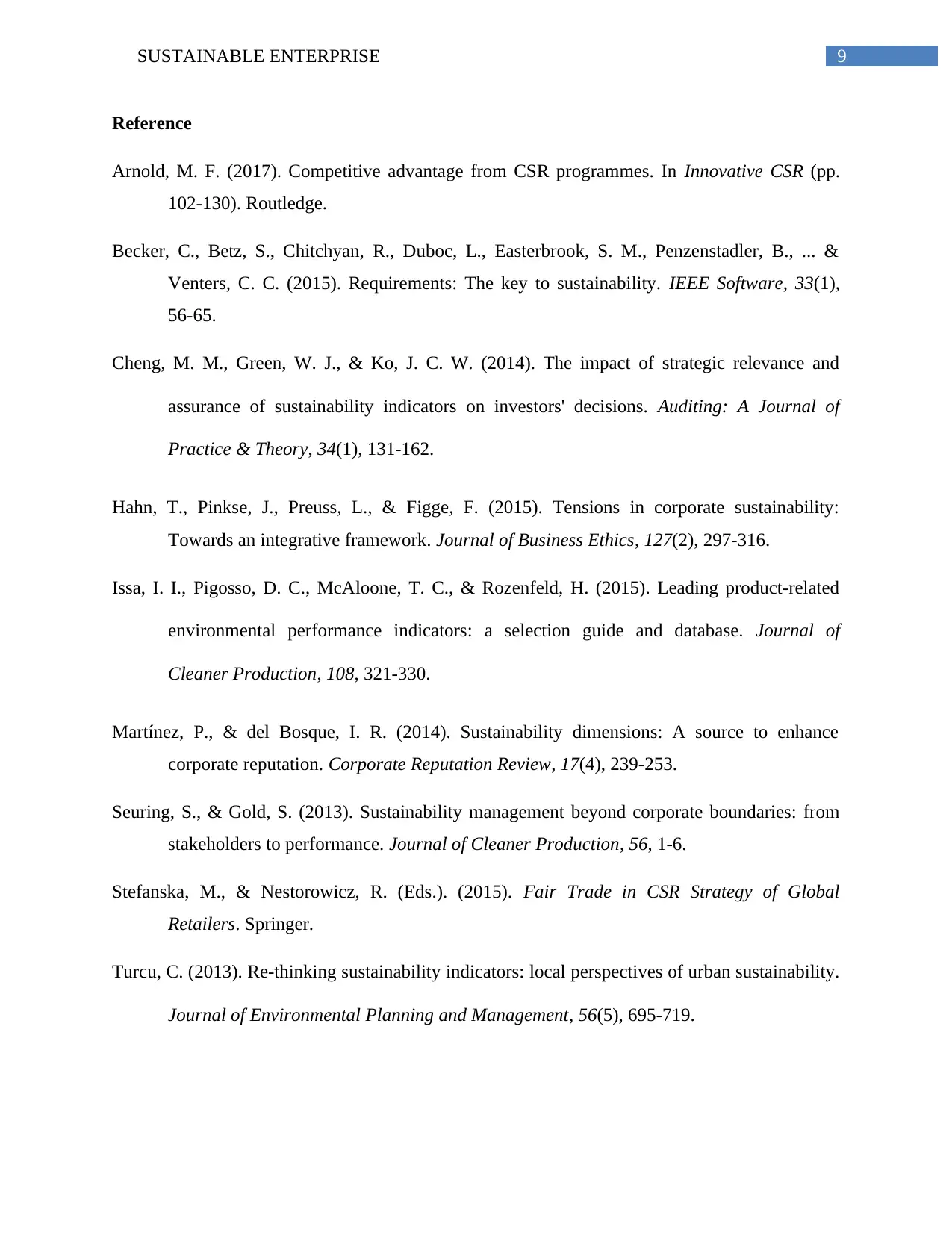
9SUSTAINABLE ENTERPRISE
Reference
Arnold, M. F. (2017). Competitive advantage from CSR programmes. In Innovative CSR (pp.
102-130). Routledge.
Becker, C., Betz, S., Chitchyan, R., Duboc, L., Easterbrook, S. M., Penzenstadler, B., ... &
Venters, C. C. (2015). Requirements: The key to sustainability. IEEE Software, 33(1),
56-65.
Cheng, M. M., Green, W. J., & Ko, J. C. W. (2014). The impact of strategic relevance and
assurance of sustainability indicators on investors' decisions. Auditing: A Journal of
Practice & Theory, 34(1), 131-162.
Hahn, T., Pinkse, J., Preuss, L., & Figge, F. (2015). Tensions in corporate sustainability:
Towards an integrative framework. Journal of Business Ethics, 127(2), 297-316.
Issa, I. I., Pigosso, D. C., McAloone, T. C., & Rozenfeld, H. (2015). Leading product-related
environmental performance indicators: a selection guide and database. Journal of
Cleaner Production, 108, 321-330.
Martínez, P., & del Bosque, I. R. (2014). Sustainability dimensions: A source to enhance
corporate reputation. Corporate Reputation Review, 17(4), 239-253.
Seuring, S., & Gold, S. (2013). Sustainability management beyond corporate boundaries: from
stakeholders to performance. Journal of Cleaner Production, 56, 1-6.
Stefanska, M., & Nestorowicz, R. (Eds.). (2015). Fair Trade in CSR Strategy of Global
Retailers. Springer.
Turcu, C. (2013). Re-thinking sustainability indicators: local perspectives of urban sustainability.
Journal of Environmental Planning and Management, 56(5), 695-719.
Reference
Arnold, M. F. (2017). Competitive advantage from CSR programmes. In Innovative CSR (pp.
102-130). Routledge.
Becker, C., Betz, S., Chitchyan, R., Duboc, L., Easterbrook, S. M., Penzenstadler, B., ... &
Venters, C. C. (2015). Requirements: The key to sustainability. IEEE Software, 33(1),
56-65.
Cheng, M. M., Green, W. J., & Ko, J. C. W. (2014). The impact of strategic relevance and
assurance of sustainability indicators on investors' decisions. Auditing: A Journal of
Practice & Theory, 34(1), 131-162.
Hahn, T., Pinkse, J., Preuss, L., & Figge, F. (2015). Tensions in corporate sustainability:
Towards an integrative framework. Journal of Business Ethics, 127(2), 297-316.
Issa, I. I., Pigosso, D. C., McAloone, T. C., & Rozenfeld, H. (2015). Leading product-related
environmental performance indicators: a selection guide and database. Journal of
Cleaner Production, 108, 321-330.
Martínez, P., & del Bosque, I. R. (2014). Sustainability dimensions: A source to enhance
corporate reputation. Corporate Reputation Review, 17(4), 239-253.
Seuring, S., & Gold, S. (2013). Sustainability management beyond corporate boundaries: from
stakeholders to performance. Journal of Cleaner Production, 56, 1-6.
Stefanska, M., & Nestorowicz, R. (Eds.). (2015). Fair Trade in CSR Strategy of Global
Retailers. Springer.
Turcu, C. (2013). Re-thinking sustainability indicators: local perspectives of urban sustainability.
Journal of Environmental Planning and Management, 56(5), 695-719.
Paraphrase This Document
Need a fresh take? Get an instant paraphrase of this document with our AI Paraphraser
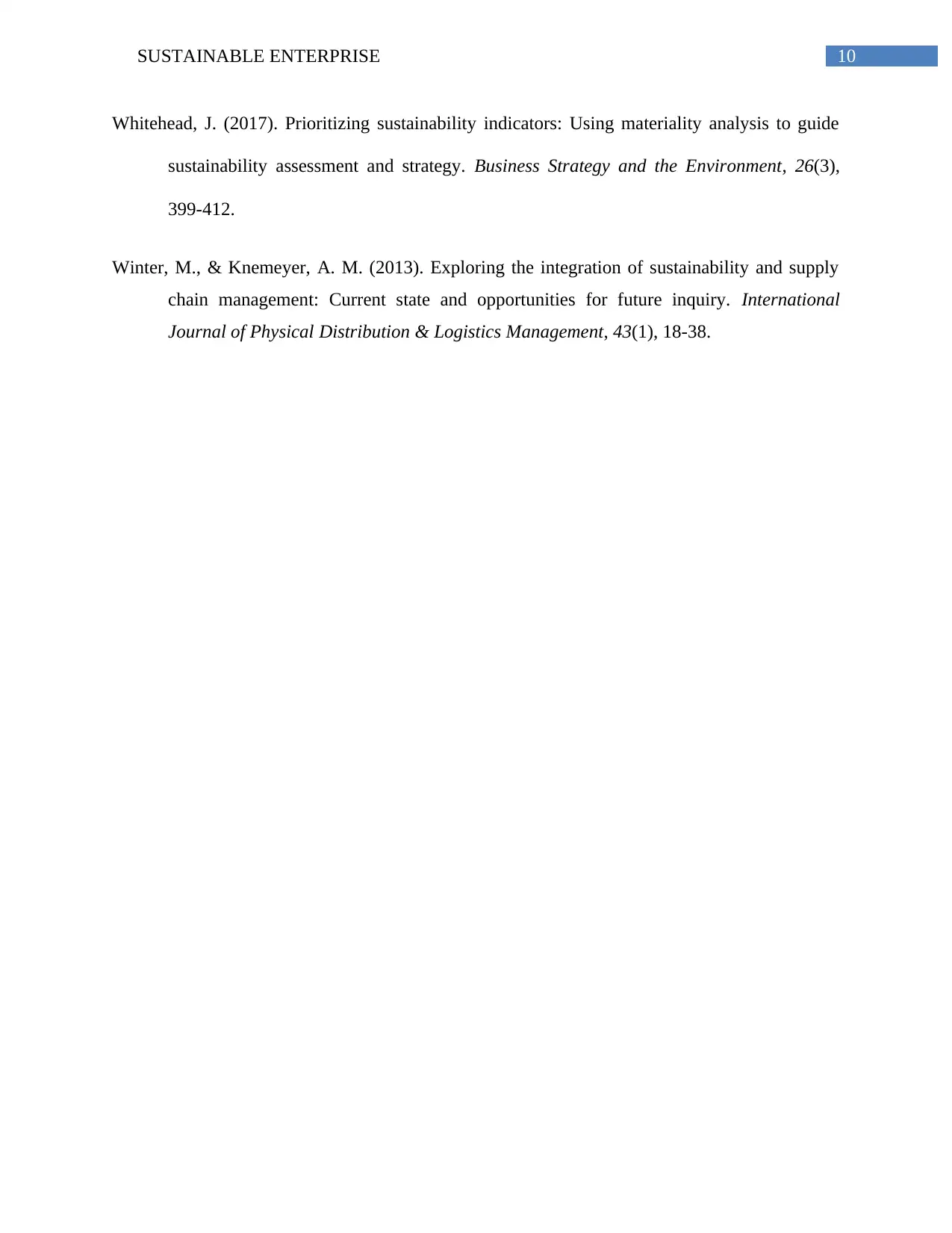
10SUSTAINABLE ENTERPRISE
Whitehead, J. (2017). Prioritizing sustainability indicators: Using materiality analysis to guide
sustainability assessment and strategy. Business Strategy and the Environment, 26(3),
399-412.
Winter, M., & Knemeyer, A. M. (2013). Exploring the integration of sustainability and supply
chain management: Current state and opportunities for future inquiry. International
Journal of Physical Distribution & Logistics Management, 43(1), 18-38.
Whitehead, J. (2017). Prioritizing sustainability indicators: Using materiality analysis to guide
sustainability assessment and strategy. Business Strategy and the Environment, 26(3),
399-412.
Winter, M., & Knemeyer, A. M. (2013). Exploring the integration of sustainability and supply
chain management: Current state and opportunities for future inquiry. International
Journal of Physical Distribution & Logistics Management, 43(1), 18-38.
1 out of 11
Related Documents
Your All-in-One AI-Powered Toolkit for Academic Success.
+13062052269
info@desklib.com
Available 24*7 on WhatsApp / Email
![[object Object]](/_next/static/media/star-bottom.7253800d.svg)
Unlock your academic potential
Copyright © 2020–2025 A2Z Services. All Rights Reserved. Developed and managed by ZUCOL.





